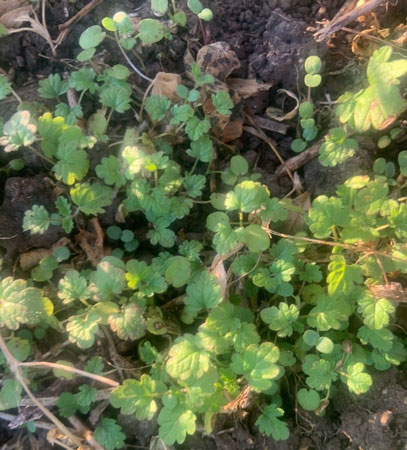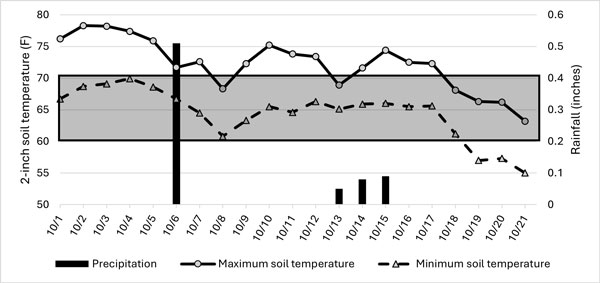Henbit is a common winter annual weed throughout much of Kansas that is thriving this fall. Recently, farmers have shared photos of especially large, dense henbit infestations in harvested corn and soybean fields, as well as other areas (Figure 1). This is likely the result of timely precipitation coupled with ideal soil temperatures (Figure 2).

Figure 1. Henbit infestation in soybean residue. Photo from David Hallauer, Meadowlark Extension District Crops Agent, K-State Extension.

Figure 2. Temperature and rainfall observed at Ashland Bottoms Research Farm near Manhattan, KS. Henbit emergence is greatest when soil temperatures are between 60°F and 70°F (gray shaded area).
Although henbit does not directly compete with summer crops, control is still important. Henbit can utilize soil water that would otherwise be available for crops, is known to host nematodes, and dense stands may lead to challenges with seedbed preparation if long stems become tangled in planting equipment.
Fall herbicide applications are an excellent way to control henbit. Emerged plants can be controlled with combinations of 2,4-D and dicamba; however, residual herbicides will be needed to prevent emergence throughout the fall or spring. Herbicides that include flumioxazin (Valor, others), sulfentrazone (Spartan, others), metribuzin (Tricor, others), or chlorimuron (Classic, others) can be used. Detailed information is available in this recent eUpdate article: https://eupdate.agronomy.ksu.edu/article/control-annual-weeds-with-fall-applied-herbicides-665-1.
Fall applications can be useful for controlling other winter annual weeds, especially marestail (also known as horseweed). More information on controlling marestail is available in this recent eUpdate article: https://eupdate.agronomy.ksu.edu/article/get-control-of-fall-emerged-marestail-before-next-spring-665-2. In addition, fall or very early spring applications can provide control of summer annual species prior to spring applications.
When considering fall or early spring applications, remember that weed control will be most effective if herbicides are applied when low temperatures are above freezing and high temperatures are in the fifties or higher for about 5 days before and after the application.
For additional information about henbit, listen to this War Against Weeds podcast with Dr. Bill Johnson. You can also refer to the 2025 Chemical Weed Control for Field Crops, Pastures, Rangeland, and Noncropland, K-State publication SRP-1190 at https://bookstore.ksre.ksu.edu/download/2025-chemical-weed-control-for-field-crops-pastures-rangeland-and-noncropland_CHEMWEEDGUIDE.
The use of trade names is for clarity to readers and does not imply endorsement of a particular product, nor does exclusion imply non-approval. Always consult the herbicide label for the most current use requirements.
Sarah Lancaster, Extension Weed Management Specialist
slancaster@ksu.edu